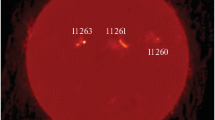Abstract
THE shortest-lived structures in microwave solar flares known until now last ∼1 s. Recently (11 April 1978) we observed a microwave outburst at 2.65 GHz (starting at 13.41 UT) showing a strong and extremely fast fluctuating burst component. Many spikes appeared to have half-power durations smaller than the 20-ms resolution of the instrument used. These are about two orders of magnitude shorter-lived than events reported from previous microwave observations. They are only rivalled by fine structure in some decimetric type IV bursts between 0.4 and 1.4GHz (ref. 1).
Similar content being viewed by others
References
Dröge, F. Astr. Astrophys. 57, 285–290 (1977).
Svestka, Z. Solar Flares 174 (Reidel, Dordrecht, 1976).
Spicer, D. S. Solar Phys. 53, 305–345 (1977).
Kuijpers, J. Astr. Astrophys. (submitted).
Author information
Authors and Affiliations
Rights and permissions
About this article
Cite this article
SLOTTJE, C. Millisecond microwave spikes in a solar flare. Nature 275, 520–521 (1978). https://doi.org/10.1038/275520a0
Received:
Accepted:
Issue Date:
DOI: https://doi.org/10.1038/275520a0
- Springer Nature Limited
This article is cited by
-
Cornelis de Jager: In Memoriam
Solar Physics (2022)
-
Extreme solar events
Living Reviews in Solar Physics (2022)
-
Flare Observations
Living Reviews in Solar Physics (2017)
-
Is Cyclotron Maser Emission in Solar Flares Driven by a Horseshoe Distribution?
Solar Physics (2016)
-
Solar flares at submillimeter wavelengths
The Astronomy and Astrophysics Review (2013)





